|
The Project Shelter: Construction
Shed
Constructed on October 23-29, 1999
This page was last updated on
21 May 2001
In order to continue working on the boat through much of the fall and winter, it was necessary to build some sort of useful shelter over the boat. The shelter will also protect the boat from moisture, bugs, dust, etc. when painting when that occurs--next summer, most likely.
There were two objectives in designing and building the shed: it had to be strong enough to withstand our Maine winters and to last without major repair for at least 1 1/2 years, and, most importantly, it needed to be inexpensively constructed. Every dollar spent on the shed means one less to spend on the boat, so the cheaper the better. I had sixty 2x4's (eight feet long) left over from a shed I constructed around my Ensign last winter, and I purchased an additional 36 2x4 (8' long) and thirty 2x4 (ten footers) to complete this shed. In addition, several bundles of cheap strapping were used as battens to secure the 6-mil plastic covering.
The design is simple: 10' tall studs for the walls, secured to 8' roof rafters. with additional 8' angled supports to secure the rafters. The roof features approximately a 31 degree angle, which should allow snow to slip easily off the plastic. This design allows for nearly 14' of interior width, with an overall height inside of 13-14'. The angled rafter supports impinge somewhat upon the open space around the boat, but shouldn't really be too much in the way. The building is quite roomy, with decent headroom immediately above the boat. I could have used horizontal collar ties instead of the angled supports, but they would have been more intrusive and more difficult to work around.
|
|
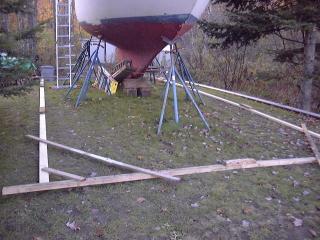 I started with a simple rectangular framework laid directly on the ground. The site is far from level side to side, and drops off sharply at the aft end of the boat, so some longitudinal leveling was necessary at the aft end. The frame was squared, but I didn't spend much time worrying about the side-to side leveling. For my purposes, this is unimportant, although the building is slightly skewed as a result. I secured the base frame to the ground by driving wooden stakes into the dirt and screwing the frame to them. I started with a simple rectangular framework laid directly on the ground. The site is far from level side to side, and drops off sharply at the aft end of the boat, so some longitudinal leveling was necessary at the aft end. The frame was squared, but I didn't spend much time worrying about the side-to side leveling. For my purposes, this is unimportant, although the building is slightly skewed as a result. I secured the base frame to the ground by driving wooden stakes into the dirt and screwing the frame to them.
|
|
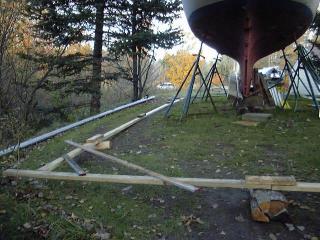
|
|
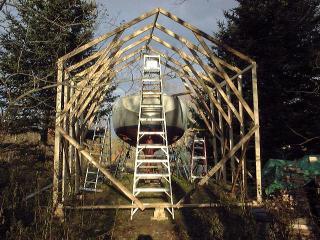 I then built and raised, one at a time, twelve frames consisting of the 10' walls, 8' rafters and 8' angled supports, all secured with 2 1/2" galvanized screws (for easy dismantling when the project is over). I built the frames on the ground ahead of the boat and raised them with a line from the boat, then walked them aft to their proper locations. The frames are three feet on center. Bracing and horizontal strapping was added as necessary to plumb and support the frames. Every several frames, I installed the pieced-together 2x4 roof ridge. Working alone, building, raising and installing the frames and ridge was completed over four days, working several hours a day. I then built and raised, one at a time, twelve frames consisting of the 10' walls, 8' rafters and 8' angled supports, all secured with 2 1/2" galvanized screws (for easy dismantling when the project is over). I built the frames on the ground ahead of the boat and raised them with a line from the boat, then walked them aft to their proper locations. The frames are three feet on center. Bracing and horizontal strapping was added as necessary to plumb and support the frames. Every several frames, I installed the pieced-together 2x4 roof ridge. Working alone, building, raising and installing the frames and ridge was completed over four days, working several hours a day.
|
|
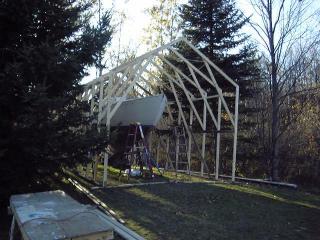
|
|
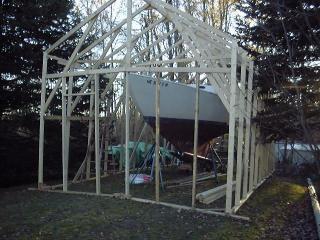 Following the completion of the main framework, I spent several hours over a couple days building the framework for the two gable ends, incorporating a doorway into the forward gable. I also installed blocking and reinforcement for the ridge, and carpet pads over the corners and rough edges to protect the plastic. Following the completion of the main framework, I spent several hours over a couple days building the framework for the two gable ends, incorporating a doorway into the forward gable. I also installed blocking and reinforcement for the ridge, and carpet pads over the corners and rough edges to protect the plastic.
|
|
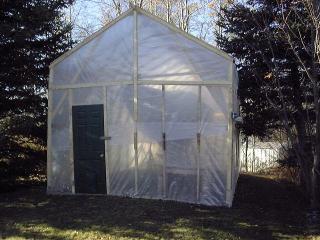 I then covered the frames with the 6 mil clear plastic, beginning with the roof. The plastic came in rolls 10' wide, so I used one roll for each side of the roof, beginning at the rear of the building and working forward, securing the plastic to the rafters on each side as I went with wooden strapping for battens to hold it in place. The size of the building meant that all securing of the roof had to be completed from on the boat or from my large stepladder, since there would be no way to reach the middle of the roof from the sides. Completing
the sheathing of the roof took the better part of a day by myself. The next day, I
covered the ends and sidewalls with plastic, which was
much easier than doing the roof. The plastic was temporarily secured with staples and a hammer tacker, then the wooden battens were nailed over the studs to hold the plastic down. This should prevent tearout in the wind. As of this writing, there has not been rain or significant wind, but given the sheltered location of the building and the success of last year's
Ensign shelter, I do not expect any problems. I then covered the frames with the 6 mil clear plastic, beginning with the roof. The plastic came in rolls 10' wide, so I used one roll for each side of the roof, beginning at the rear of the building and working forward, securing the plastic to the rafters on each side as I went with wooden strapping for battens to hold it in place. The size of the building meant that all securing of the roof had to be completed from on the boat or from my large stepladder, since there would be no way to reach the middle of the roof from the sides. Completing
the sheathing of the roof took the better part of a day by myself. The next day, I
covered the ends and sidewalls with plastic, which was
much easier than doing the roof. The plastic was temporarily secured with staples and a hammer tacker, then the wooden battens were nailed over the studs to hold the plastic down. This should prevent tearout in the wind. As of this writing, there has not been rain or significant wind, but given the sheltered location of the building and the success of last year's
Ensign shelter, I do not expect any problems.
Total cost of the shelter, not including the sixty used 2x4 from last year, was about $350, including roofing nails for the strapping, galvanized screws and about 2500 staples.
|
|
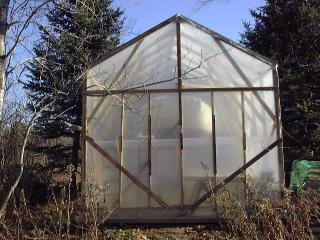
Here's a view of the back of the completed
shed. I ran out of plastic and had to use a piece of 4 mil. (thinner)
plastic to cover the bottom half of the aft gable.
|
|
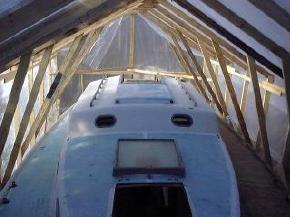
|
|
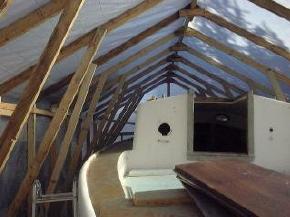 As
the project progresses, I will post updates to see how the shed is holding up,
and any changes that are required. (Please see below for updates.) As
the project progresses, I will post updates to see how the shed is holding up,
and any changes that are required. (Please see below for updates.)
|
|
UPDATE!!
3 November 1999
Well, we had heavy rain and strong winds last night, and I'm happy to say the shed held up great! No problems to report. A few minor leaks here and there through staple holes and the like, but no significant problems. I'll probably add some additional strapping over the outside of the studs to help hold down the plastic (it's currently only every other stud), but that's about it. Wind gusts probably exceeded fifty knots, so it's unlikely to get much worse.
UPDATE!!
21 December 1999
The shed is holding up very well as time goes on. I have added some extra strapping over some of the studs to help hold the plastic down, as the staples rip out easily. Ventilation is fair, although condensation does build up on the inside of the plastic in some weather conditions. There have been several significant wind storms, accompanied by rain, and things are still in good condition. It gets quite warm inside on sunny days, especially at deck level. The condensation has not yet been a problem, but it does form on the outside of the hull, and it drips onto the deck from the roof. When the time comes to paint, extra precautions will be taken to ensure no condensation.
|
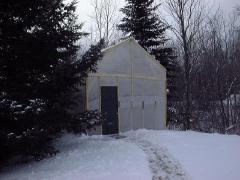 UPDATE!!
17 January 2000 UPDATE!!
17 January 2000
We finally got our first snowfall of the season yesterday, after 305 days since the last storm (smashed the previous record). The shed held up very well, as most of the snow slid or blew right off the roof. More heavy winds the past couple weeks have not harmed the shed at all.
|
|
UPDATE!!
27 March 2000
Other snowstorms during the
winter also proved to be no problem for the shed. The roof has stretched
somewhat, allowing some air and water in at times, and I intend to roll some new
plastic out over the top seam to keep things watertight, as I will be painting
at some point during the summer.
In preparation for the warmer
weather to come, and to make working on the boat tolerable during the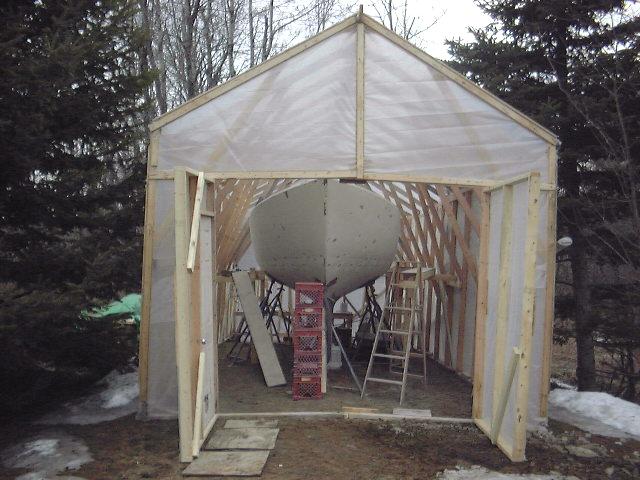 summer months--while still keeping it under cover for protection--I modified the
front end of the shed to include two large outswinging doors. When open,
these provide lots of light and fresh air. A little bit later, I plan to
do the same thing to the back side of the shed for good cross ventilation.
This should keep the temperature workable, I hope--on the warmest days so far it
is already getting very warm at the deck level.
summer months--while still keeping it under cover for protection--I modified the
front end of the shed to include two large outswinging doors. When open,
these provide lots of light and fresh air. A little bit later, I plan to
do the same thing to the back side of the shed for good cross ventilation.
This should keep the temperature workable, I hope--on the warmest days so far it
is already getting very warm at the deck level.
It will also be nice to not be
closed in with sanding dust and the like during the summer, too.
 Shed with doors closed
Shed with doors closed
|
|
UPDATE!!
18 April 2000
Over the weekend I took care of a couple small
issues with the shed. First, I ran some new plastic sheeting over the roof
from side to side to help seal off a couple leaks at the ridge, and to basically
shore up the roof to get us through the next year. It has held up very
well to this point, but the leaks from the original seam at the ridge, the two
sheets of plastic used to cover the roof met, was getting annoying, and I will
want to be able to keep the boat as dry as possible when the time comes to
paint. I secured the new plastic with staples and strips of strapping
nailed down to help hold it.
I also cut an opening in the rear gable end of
the shed, so I can get some cross ventilation. We had some very
warm, summer-like weather on Saturday, April 15--up to 75 degrees--and it was
unbearable on the deck of the boat. The big front doors certainly help,
but the rear opening was needed. I also think that once the trees behind
the boat leaf out in a few weeks that the shade produced will help temper the
heat in the greenhouse-like shed. What little bit of grass that remains
around the boat is growing strongly now!
I'll post any more shed updates if I make
other modifications.
|
|
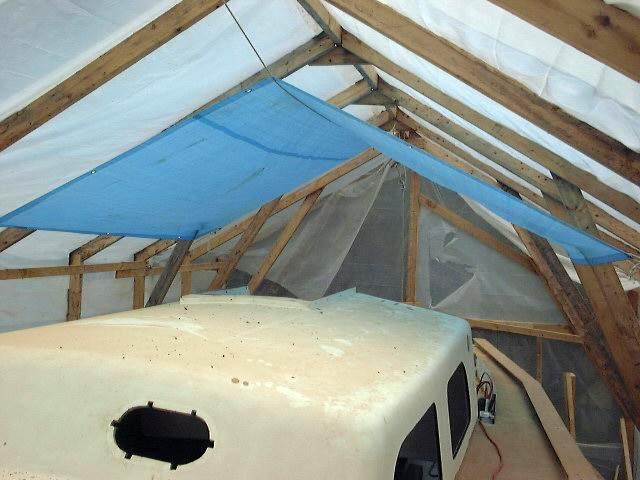 UPDATE!!
27
July 2000 UPDATE!!
27
July 2000
There
are a few leaks here and there in the shed, and it gets very warm when the sun
is hitting it right. Fortunately, there are a lot of trees around--and
therefore shade for much of the day--but I needed something to cut the heat
somewhat.
To do this, and also provide me with a
waterproof area to store tools, etc. without worrying, I strung up a small tarp
over the companionway and cockpit. This provides some shade and protects
the area from water drippage.
|
|
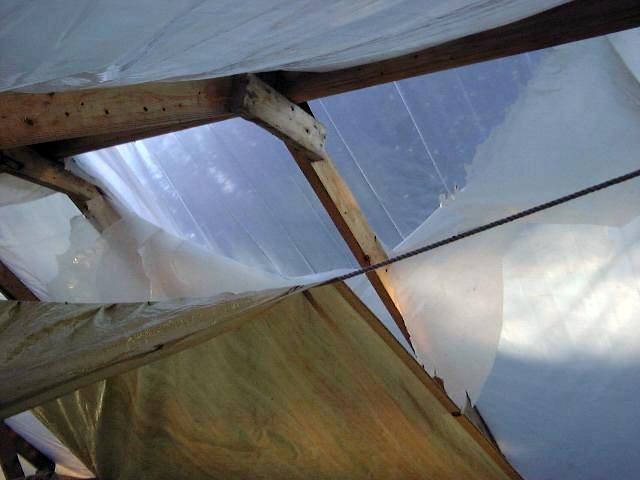 UPDATE!!
18 October 2000 UPDATE!!
18 October 2000
The plastic has begin to fall
apart at the ridge, damaged by the sun. In some areas, it is dried and
cracking, dropping little pieces of plastic on the boat and leaving small holes
above.
To combat this through the
coming winter, I ran some new plastic over the top from side to side, just like
I did earlier in the spring, although this covered a slightly different
area. I may have to pull a blue poly tarp over the ridge sometime,
depending how the clear plastic holds up. I also installed another small
tarp inside the shed, similar to the one above, over the forward portion of the
boat.
|
|
UPDATE!!
3 November 2000
Well, the shed is slowly but
surely falling apart. It would appear that the life expectancy of clear
polyethylene plastic is about a year in direct sunlight--I have widespread
failures beginning. With winter just around the corner, I figured I wouldn't
rely on the new plastic I had spread over portions of the roof previously.
A catastrophic failure in the middle of winter would be a real pain.
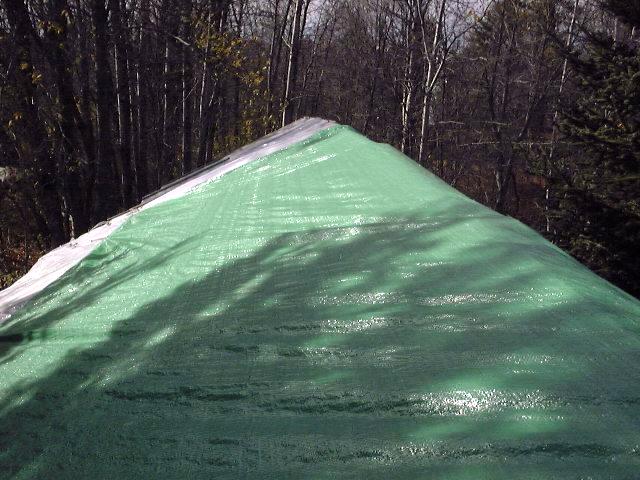 I
spread two tarps over the forward and rear portions of the shed, covering the
areas with the most evidence of damage. There is only a small portion of
the ridge not covered, approximately amidships. Working from my big
stepladder and another ladder, I painstakingly pulled these tarps over the roof,
moving from side to side as necessary. They do not cover the entire
roof--only the middle portion at the ridge, the area where the damage is occurring.
I tied and nailed the tarps down as necessary to properly stretch them
out. Because of the difficulty involved in covering the final, center
portion (only a couple feet--and the plastic there is (so far) in good shape) I
didn't bother worrying about that area. I
spread two tarps over the forward and rear portions of the shed, covering the
areas with the most evidence of damage. There is only a small portion of
the ridge not covered, approximately amidships. Working from my big
stepladder and another ladder, I painstakingly pulled these tarps over the roof,
moving from side to side as necessary. They do not cover the entire
roof--only the middle portion at the ridge, the area where the damage is occurring.
I tied and nailed the tarps down as necessary to properly stretch them
out. Because of the difficulty involved in covering the final, center
portion (only a couple feet--and the plastic there is (so far) in good shape) I
didn't bother worrying about that area.
|
|
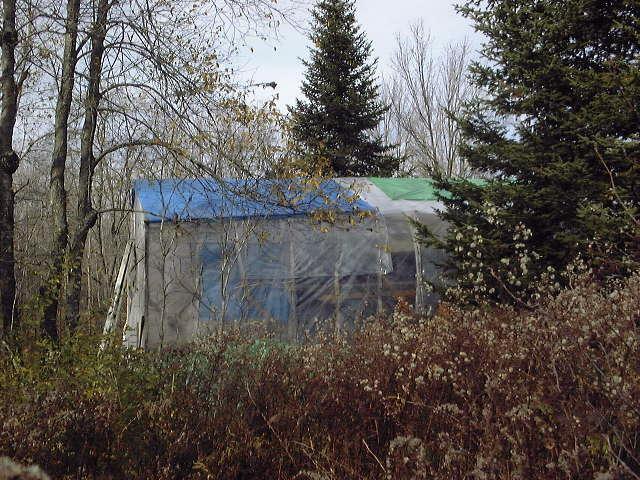
|
|
UPDATE!!
8 March 2001
Well, the shed has continued to
survive a tough winter here in Maine. Several weeks ago, I had to spread
yet another blue tarp over the top of the shed--the after blue tarp (seen above)
had blown partially off, since the grommets were rotten and pulled out in the
wind, and that little remaining area of the clear plastic sheeting finally caved
in under the weight of the snow we've been having all winter. I spent a
couple hours pulling the tarp over the roof and securing it with lines to the
framework. It's a brand new tarp, so I expect it will survive the next
couple months in good shape. I don't see any worries looming on the
horizon, although there are some slits and holes in the front gable, caused by
UV degradation. I'll probably patch these up just to prevent a severe rip
from forming, although it's really not that important.
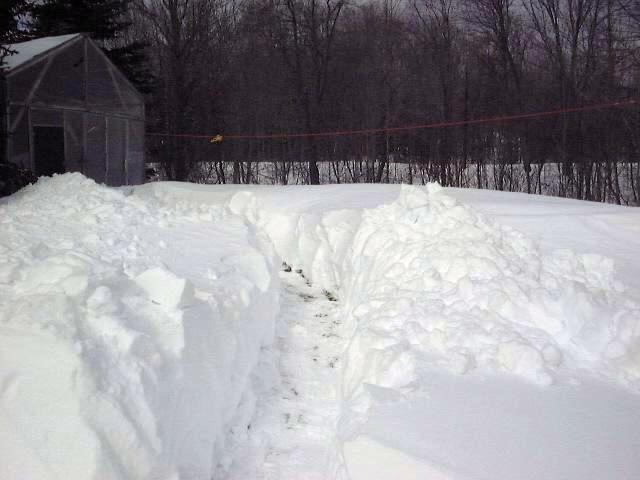 The
shed survived the Blizzard of 2001 (3/6/01) just
fine, thank you. We had very heavy winds, along with two feet of
snow. The wind kept any snow from building up on the roof, and the frame
seems to be rock steady anyway. No new damage to report. The shed is
certainly looking tired and worse for the wear, but it's doing its job. I
attribute the success of this cheap shelter to a couple things: incredible
talent used in its initial construction (ha ha), and, more importantly (and
truthfully) to its relatively sheltered location. There are 40-foot blue
spruce trees on either side, which are literally touching the shed, and the
whole general area is surrounded by trees and brush, without a large open
fetch. This building in an open field would never have made it, I am
convinced. The
shed survived the Blizzard of 2001 (3/6/01) just
fine, thank you. We had very heavy winds, along with two feet of
snow. The wind kept any snow from building up on the roof, and the frame
seems to be rock steady anyway. No new damage to report. The shed is
certainly looking tired and worse for the wear, but it's doing its job. I
attribute the success of this cheap shelter to a couple things: incredible
talent used in its initial construction (ha ha), and, more importantly (and
truthfully) to its relatively sheltered location. There are 40-foot blue
spruce trees on either side, which are literally touching the shed, and the
whole general area is surrounded by trees and brush, without a large open
fetch. This building in an open field would never have made it, I am
convinced.
|
|
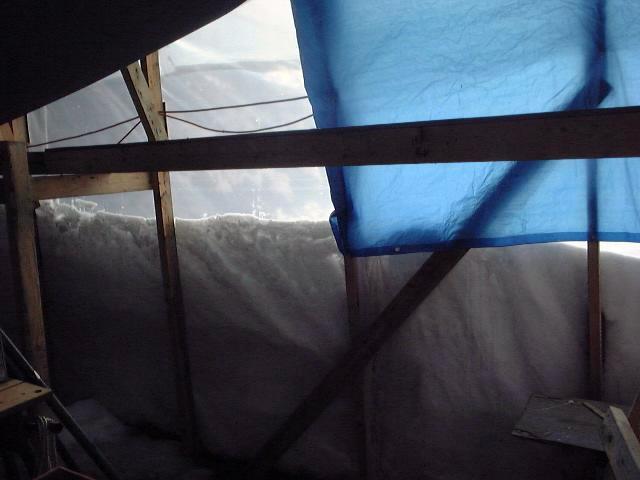 Also,
the more snow we get during the winter, the more secure the shed becomes, since
the snow accumulates at the base of the shed, and this amount is augmented by
the snow that slides off the roof. This provides a nice, solid cement-like
external foundation that really seems to hold things in place. This photo
shows the snow level outside the shed (taken from inside). That's about 4
feet high! Also,
the more snow we get during the winter, the more secure the shed becomes, since
the snow accumulates at the base of the shed, and this amount is augmented by
the snow that slides off the roof. This provides a nice, solid cement-like
external foundation that really seems to hold things in place. This photo
shows the snow level outside the shed (taken from inside). That's about 4
feet high!
The shed has really done a fine
job protecting the boat and allowing work to go on. Fortunately, it
only has to hold back the weather a couple more months at most, and with the end
of winter looming (hopefully) closer all the time, it has survived one it its
last tests in this last storm. As soon as warmer weather arrives, I am
looking forward to opening things up a little by removing the front doors and
some of the plastic on the sides. I'm getting antsy to actually step back
and look at my boat; I've only seen it from close up for the past year and a
half. I'm undecided at the moment if I'm going to dismantle the shed with
the boat inside, before launch, or if I will remove only what is necessary to
pull the boat out with the framework intact. I don't want to risk damaging
the boat, but at the same time having the boat there makes working on the high
framework substantially easier. More on this later.
|
|
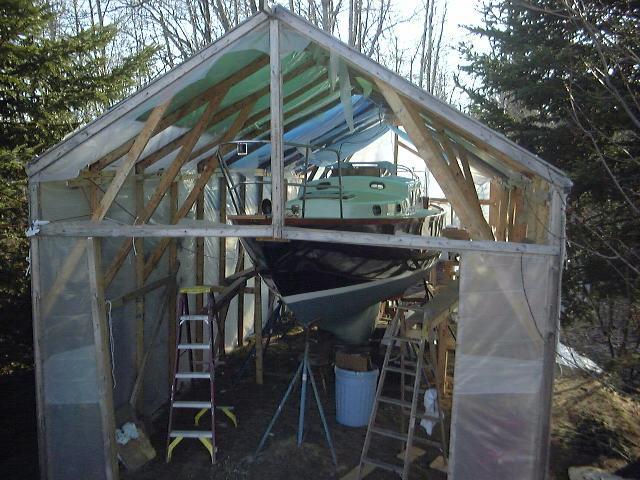 UPDATE!!
29 April 2001 UPDATE!!
29 April 2001
Last
weekend, I opened up the front of the shed--it was mostly there anyway, since
the plastic had been ripping steadily. It's just been too hot on deck, and
I needed the airflow. Plus, I'm dying to see the boat from a
distance! I removed the big doors, and ripped open the plastic
sheeting. Later, I'll remove the framing from the gable end. With a
couple weeks, I expect to remove the entire shed, probably a week or so before
launching.
|
|
Dismantling
the Shed May
20-21, 2001
I ended up leaving the shed up
until the boat was launched. I had last minute projects on deck, and it
was much more convenient to have the shelter. Before moving the boat, I
did remove all the angled roof support pieces, and the entire front of the shed.
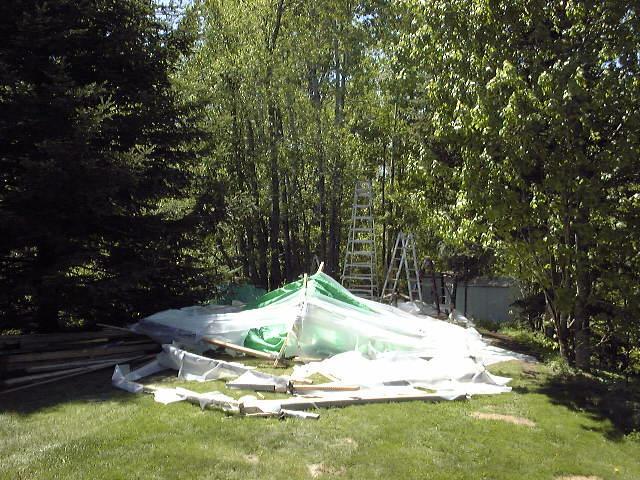 A
couple days after launching, I removed all my tools, parts, and other project
remnants from the shed. Then, later, I began dismantling the thing. I
didn't bother with finesse...from my tall stepladder, I began cutting the ridge,
first one, then two sections at a time. Then, I removed screws at each
side of the shed, where I had held the frames the proper distance apart during
construction with strapping. After slicing up the plastic as necessary, I
simply rocked the frames until they fell over--sometimes easily, sometimes
standing tall tenaciously. The whole thing was amazingly rugged. When I
neared the back end of the shed, I got impatient and, tying a line to the back
end, pulled down the last four sections all at once. This left me with a
big pile of lumber and plastic to deal with. A
couple days after launching, I removed all my tools, parts, and other project
remnants from the shed. Then, later, I began dismantling the thing. I
didn't bother with finesse...from my tall stepladder, I began cutting the ridge,
first one, then two sections at a time. Then, I removed screws at each
side of the shed, where I had held the frames the proper distance apart during
construction with strapping. After slicing up the plastic as necessary, I
simply rocked the frames until they fell over--sometimes easily, sometimes
standing tall tenaciously. The whole thing was amazingly rugged. When I
neared the back end of the shed, I got impatient and, tying a line to the back
end, pulled down the last four sections all at once. This left me with a
big pile of lumber and plastic to deal with.
|
|
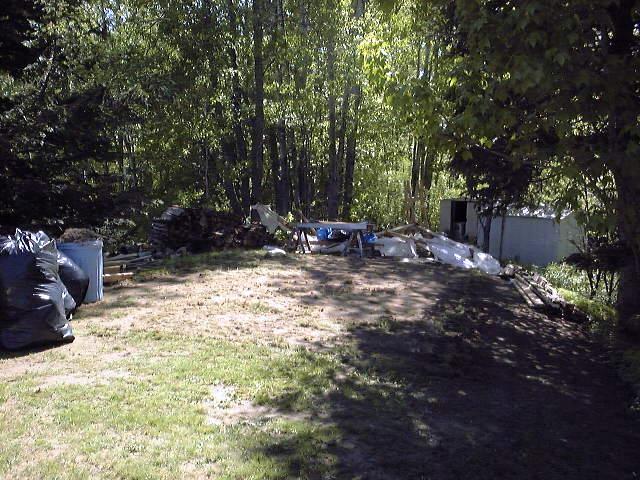 Next,
I began ripping everything apart, not bothering with removing the screws, but
just pulling things apart as needed. This was a big job--remove the
strapping holding down the plastic, remove the plastic, and rip apart the
frames. After a couple hours of this, I had most of the shed reduced to a
pile of lumber and trash, except for the back end. I took care of this the
next day. Next,
I began ripping everything apart, not bothering with removing the screws, but
just pulling things apart as needed. This was a big job--remove the
strapping holding down the plastic, remove the plastic, and rip apart the
frames. After a couple hours of this, I had most of the shed reduced to a
pile of lumber and trash, except for the back end. I took care of this the
next day.
I ended up with some large
piles of lumber, and 8 or 10 huge trash bags containing the plastic and
tarps. It was weird to see that part of the yard open again, after so
long.
I almost felt like I was
betraying the shed, after it served me so well for so long. For a
building with such lightweight and inexpensive construction, it surpassed all my
expectations. I might make a few minor changes were I to build again,
based on the lessons learned from this time around.
|
|